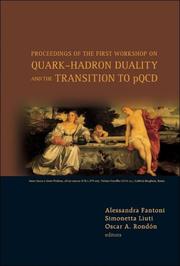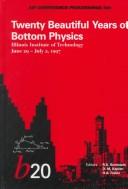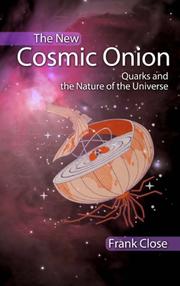| Listing 1 - 10 of 385 | << page >> |
Sort by
|
Book
Year: 1969 Publisher: New York (N.Y.) : Benjamin,
Abstract | Keywords | Export | Availability | Bookmark
 Loading...
Loading...Choose an application
- Reference Manager
- EndNote
- RefWorks (Direct export to RefWorks)
Book
ISBN: 0511599870 Year: 1983 Publisher: Cambridge : Cambridge University Press,
Abstract | Keywords | Export | Availability | Bookmark
 Loading...
Loading...Choose an application
- Reference Manager
- EndNote
- RefWorks (Direct export to RefWorks)
This short account of elementary particles written for the layman poses the questions: are quarks the fundamental building blocks of matter; what are they like; how many different kinds exist; and can they exist in the free state? What is the ultimate structure of matter? Is it made of atoms, small, simple, indivisible particles, or not? John Dalton's 'chemical atoms' turned out to be composite, composed of an electron cloud and a very small, very dense nucleus. This nucleus, in turn, was found to be composite, made up of protons and neutrons bound together by pions. All three of these (and many like particles) have now been found to be made of quarks. At first there were only three of these and they were thought to be long sought after fundamental building blocks. But now we know of at least 18 quarks, 18 anti-quarks and eight 'gluons' that hold the quarks together. The whole atomic idea is in doubt and the alternate possibility of a Universe that is one, whole and indivisible opens up. This fascinating book will be an inspiration to anyone wishing a first exposure to this intriguing and mystical area of modern physics.
Book
ISBN: 9789814618106 9789814618090 9814618101 9814618098 Year: 2015 Publisher: Singapore: World scientific,
Abstract | Keywords | Export | Availability | Bookmark
 Loading...
Loading...Choose an application
- Reference Manager
- EndNote
- RefWorks (Direct export to RefWorks)
Book
ISBN: 0140158634 9780140158632 Year: 1992 Publisher: London : Penguin books,
Abstract | Keywords | Export | Availability | Bookmark
 Loading...
Loading...Choose an application
- Reference Manager
- EndNote
- RefWorks (Direct export to RefWorks)
Book
Year: 1976 Publisher: Paris : IN2P3,
Abstract | Keywords | Export | Availability | Bookmark
 Loading...
Loading...Choose an application
- Reference Manager
- EndNote
- RefWorks (Direct export to RefWorks)

ISBN: 1281919306 9786611919306 9812774130 9789812774132 9789812566843 9812566848 9812566848 9781281919304 6611919309 Year: 2006 Publisher: Hackensack, NJ World Scientific
Abstract | Keywords | Export | Availability | Bookmark
 Loading...
Loading...Choose an application
- Reference Manager
- EndNote
- RefWorks (Direct export to RefWorks)
While perturbative QCD methods fully describe experimental results at high energies, and chiral perturbation theory is the low energy effective theory of the strong interactions, a form of duality is observed connecting these two regimes. In these intermediate kinematics, a wide variety of reactions are observed which can be described simultaneously by single particle (quark) scattering, and by exclusive resonance (hadron) scattering.The contributions in this proceedings volume discuss recent and existing results, and aim to foster current and future research, investigating the phenomenon of quark-hadron duality.This unique volume contains research work by scientists from different arenas of hadronic physics, dealing with different manifestations of quark-hadron duality.

ISBN: 1563967456 Year: 1998
Abstract | Keywords | Export | Availability | Bookmark
 Loading...
Loading...Choose an application
- Reference Manager
- EndNote
- RefWorks (Direct export to RefWorks)
Quarks --- Congresses
Book
Year: 1979 Publisher: New York, NY : Academic Press,
Abstract | Keywords | Export | Availability | Bookmark
 Loading...
Loading...Choose an application
- Reference Manager
- EndNote
- RefWorks (Direct export to RefWorks)

ISBN: 9812793712 9789812793713 9810242360 9789810242367 Year: 2000 Publisher: Singapore [River Edge] N.J. World Scientific
Abstract | Keywords | Export | Availability | Bookmark
 Loading...
Loading...Choose an application
- Reference Manager
- EndNote
- RefWorks (Direct export to RefWorks)
The confinement mechanism of the quarks in QCD is one of the most challenging and open problems in physics. Confinement is a nonperturbative phenomenon, and a definite way to handle it has not yet been found in field theory. There are lattice calculations that can produce the low-lying states of the spectrum and "measure" many important physical quantities, but nevertheless the development of analytical techniques is of extreme importance for understanding the physics involved in confinement. In this respect it is important to test the results obtained directly from the theory (Bethe-Salpeter

ISBN: 9781584887980 1584887982 Year: 2007 Publisher: New York (N.Y.): Taylor & Francis,
Abstract | Keywords | Export | Availability | Bookmark
 Loading...
Loading...Choose an application
- Reference Manager
- EndNote
- RefWorks (Direct export to RefWorks)
Quarks --- Cosmology --- Cosmologie
| Listing 1 - 10 of 385 | << page >> |
Sort by
|

 Search
Search Feedback
Feedback About UniCat
About UniCat  Help
Help News
News